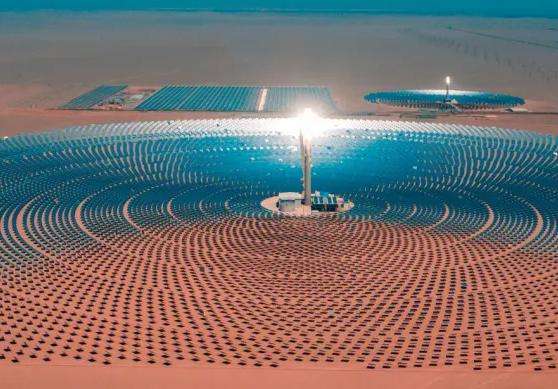A solar cell is a device that reacts to light and converts light energy into electricity. There are many types of materials that can produce photovoltaic effects, such as: monocrystalline silicon, polycrystalline silicon, amorphous silicon, gallium arsenide, copper selenium indium, etc. Their principles of energy production are basically the same. Today, crystalline silicon is used as an example to describe the photovoltaic power production process. Crystalline P-type silicon is doped with phosphorus to obtain N-type silicon, forming a P-N junction.
When light irradiates the surface of the solar cell, part of the photons is absorbed by the silicon material; the energy of the photons is transferred to the silicon atoms, causing the electrons to migrate and become free electrons which accumulate on both sides of the P-N junction toform potential. Wrong, when the external circuit is connected, under the action of this voltage, a current will flow through the external circuit to produce a certain output power. The essence of this process is: the process of converting photon energy into electrical energy.
1. Solar power generation methods There are two solar power generation methods, one is light-heat-electricity conversion method and the other is direct light-electricity conversion method.
(1) The light-heat-electricity conversion method uses thermal energy generated by solar radiation to produce electricity. Generally, a solar collector converts the absorbed thermal energy into steam as the working fluid and then drives it away. a steam turbine to produce electricity. The first process is a light-heat conversion process; the second process is a processs heat-to-electricity conversion, which is identical to ordinary thermal energy production. The disadvantages of solar thermal energy production are low efficiency and high cost. Its investment is estimated to be at least 5 to 10 times more expensive than that of ordinary thermal power plants. A 1,000 MW solar thermal power plant requires an investment of 2.0 to 2.5 billion US dollars, and the average investment for 1 kW is 2,000 to 2,500 US dollars. Therefore, it is suitable for small-scale special occasions, but large-scale use is not economically profitable and cannot compete with ordinary thermal or nuclear power plants.
(2) Direct light-to-electricity conversion method This method uses the photoelectric effect to directly convert solar radiation energy into electrical energy. The basic device for converting light intoelectricity is the solar cell. A solar cell is a device that directly converts solar energy into electrical energy through the photovoltaic effect. When the sun shines on the photodiode, the photodiode converts light energy from the sun into electrical energy, producing current. When many batteries are connected in series or parallel, a solar cell array with relatively large output power can be formed. Solar cells are a promising new energy source with three major advantages: solar cells have a long lifespan and can be invested once and used for a long time as long as the sun exists, they are different from production thermal energy; and nuclear energy production. In comparison, solar cells do not cause environmental pollution; solar cells can be used in both dhe sizes large, medium and small, ranging from a medium-sized power plant with a million kilowatts to a solar battery for just one. domestic, which is unmatched by other energy sources.
Solar cells, also known as "solar chips" or "photovoltaic cells", are optoelectronic semiconductor sheets that use sunlight to directly generate energy. electricity. As long as it is illuminated by light that meets certain lighting conditions, it can instantly produce voltage and generate current if there is a loop. In physics, it is called solar photovoltaic (Photovoltaic, abbreviated PV), abbreviated photovoltaic. Solar cells are devices that directly convert light energy into electrical energy by photoelectric effect or photochemical effect. Thin film solar cells that work with the photoelectric effecte are the most widespread, while solar cells that work with the photochemical effect are still in their infancy. When light irradiates the pn junction, electron-hole pairs are generated. The carriers generated near the P-N junction inside the semiconductor are not recombined and reach the space charge region. Attracted by the internal electric field, the electrons circulate in the n region and in the n region. holes Flows into the p region, resulting in excess electrons being stored in the n region and excess holes in the p region. They form a photogenerated electric field near the p-n junction opposite the direction of the potential barrier. In addition to partially compensating the effect of the barrier electric field, the photogenerated electric field also makes the p region positively charged and the N region negatively charged. An electromotive force is generated in the thin layer between the regionn N and the region P. is the photovoltaic effect.
When energy is added to pure silicon (for example, in the form of heat), several electrons break away from their covalent bonds and leave the atom. Every time an electron leaves, a hole is left behind. These electrons then wander around the crystal lattice, looking for another hole to settle into. These electrons are called free carriers and can carry electric current. By mixing pure silicon and phosphorus atoms, it only takes a small amount of energy to escape some of the “extra” electrons from the phosphorus atoms (the five outermost electrons). When doped with phosphorus atoms, the resulting silicon is known as N-type (). the "n" means negative), only part of a solar cell is type N. Another part of the silicon is doped with boron. The outermost boron electron shell does not containonly three electrons instead of four, which makes it possible to obtain P-type silicon.














